yeovil people
Samuel Cridland
Victorian mason and builder
Samuel Cridland was born in Bradford Abbas, Dorset, just south of Yeovil, in 1834. He was the son of mason William Cridland (1807-1867) and Mary née Hobbey (1807-1892). In the 1841 census William and Mary were living in Bradford Abbas with their children Henry (b 1833), 6-year old Samuel, Susan (b 1836) and Sarah (b 1840). William's brother George, also a mason, lived next door with his family. In the 1851 census the family were still in Bradford Abbas and William and his two elder sons Henry and Samuel, aged 18 and 16 respectively, all gave their occupations as Journeyman Masons.
In 1856, at the age of 22, Samuel married Letitia Culliford (1835-1866) at Yeovil. They were to have five children; Frederick, known as Fred and later as Ned (b 1857), Elizabeth Caroline, known as Caroline (b 1859), Herbert (b 1861), Emily (b 1863) and Kate (b 1865). Samuel and Letitia moved to Yeovil and in the 1861 census they were listed living in Middle Street, just before Commercial Buildings (roughly opposite Wilkinson's in today's terms) with their first three children and Letitia's widowed mother Bethia. Samuel listed his occupation as a stone mason.
Nevertheless, although listed as a stone mason in 1871, Samuel was already a house builder and his earliest known speculative housing project was North Terrace in New Town where the datestone set into the wall at the southern end of the terrace reads 'SC 1871'. For simple domestic properties the buildings display ornate architectural detailing based on Greek Doric architecture.
Sadly Letitia died in 1866, aged just 31. The following year Samuel married Susan Rowland (1837-1898) at Yeovil. They were to have two children; Lucy (b 1868) and William (b 1871). In the 1871 census Samuel and Susan were listed in South Street with their children and Samuel gave his occupation as Master Mason. From their location in the census it would appear that they lived on the south side of South Street close to Park Street. A yard is shown on the 1886 Ordnance Survey in this area and it may have been Samuel's builders yard.
A large vellum document in my collection, dated 1875, in which Samuel Cridland leased from Yeovil Corporation the property known as Stars Lane House and a large area of land off Stars Lane - essentially what is now the whole of Stars Lane car park. On this lease the future Summerhouse Terrace was drawn on the plan and shown as an un-named ‘proposed road’ - see below. The terrace of houses on its north side was built, coincidentally, in 1875 although whether built by Samuel Cridland or not is unknown at this time (but, if I were a betting man....).
In the 1881 census Samuel and Susan were listed with the children at 16 South Street, between today's King George Street and Union Street. Samuel and sons Ned (Frederick) and Herbert all listed their occupations as masons. It is likely that Samuel rebuilt his house in 1887 as shown in the last two photographs below.
In 1883 Samuel obtained several "pieces of land in Vicarage Street" from the Corporation.
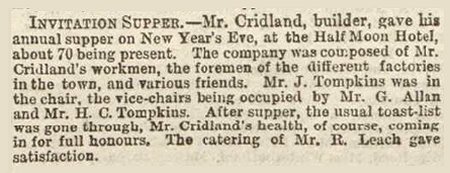
Western Gazette,
9 January 1885
|
In the 1891 edition of 'Where to Buy' Samuel Cridland's business was given the following description -
Mr
Samuel
Cridland The number of new buildings erected in Yeovil during the past twenty years indicates great activity in the general business of the town, and in the building trade particularly. The skillful manner in which the work has, in the main, been performed, and the excellent taste shown in harmonising the new edifices with their surroundings, at the same time that every modern improvement has been introduced, is highly creditable to their builders, and is in every way worthy of the traditions of the district. A house that has exhibited special activity during recent years is Mr Samuel Cridland, builder, decorator, etc., of South Street, and judging from the strides it has made since it was established twenty-four years ago, bids fair to assume a good position in the near future. The business is a progressive one, Mr Cridland being an enterprising, practical, and long experienced man. Fully alive to the requirements of the trade and of the public, he adopted the latest improvements, and enjoys a large patronage. His premises are conveniently accessible from all parts, the showroom containing a varied stock of choice paper-hangings, cornices, mouldings, and other necessaries of the business. Sanitary considerations are carefully attended to and every improved appliance suggested by modern science for closets, sink-traps, etc., is supplied. Mr Cridland retains a large staff of men in his employment to undertake building orders, sanitary work, decorating, paperhanging, and similar work, and he has been entrusted with the carrying out of many important contracts in all parts of the county. One notable feature in Mr Cridland's method of doing business should not be lost sight of, viz., estimates being prepared and contracts entered into, he strictly adheres to the letter of the agreement. By this means the work is always performed to the satisfaction of his customers.
|
|
From the
diary of
Louisa
Harris ....
|
Samuel Cridland died on 10 November 1891 at Yeovil and on 14 November 1891 the Bristol Mercury and Daily Post reported - "On Thursday morning an inquest was held before Mr EQ Louch, deputy coroner, on the body of Mr Samuel Cridland, who met his death by falling down a well on Tuesday. Supt. Self having given evidence as to the disused well, PC Hicks said that on Wednesday morning he went to the rear of the police station, where he saw Mrs Self, who said she had heard some noises in the well. He told her he thought someone ought to be seen about it. Both of them walked several times over the place where deceased fell in, but they did not think that it was likely to give way. After breakfast witness saw deceased near the station, and told him there was something the matter with the well. Deceased went round with witness to look at the well, and when he was near the sunken stone witness called out to him not to go any further, but at the same time the stone he was standing on gave way, and deceased fell in. Witness saw deceased catch at the handle of the pump, but he missed it. Dr Colmer said he examined the body. He thought deceased was stunned by the fall. The jury returned a verdict of 'Accidental death'. Much sympathy is felt for the deceased's family."
His will was proved in Taunton in the July with his effects amounting to £839 11s 11d (worth in excess of £500,000 at today's value).
gallery

From an
indenture in my
collection
Samuel Cridland's seal and signature on an indenture dated 1875.
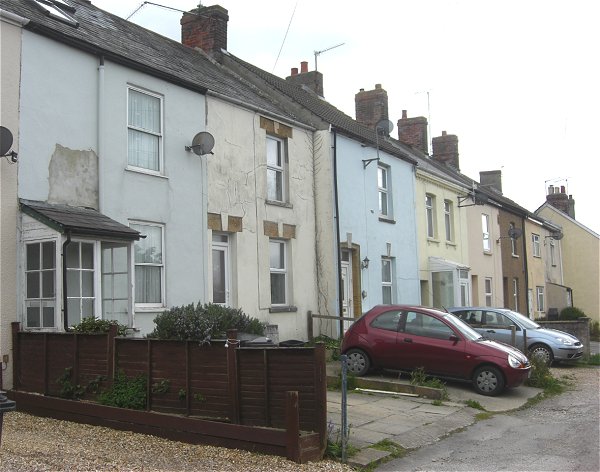
North Terrace, built by Samuel Cridland in 1871 and photographed by me in 2013.
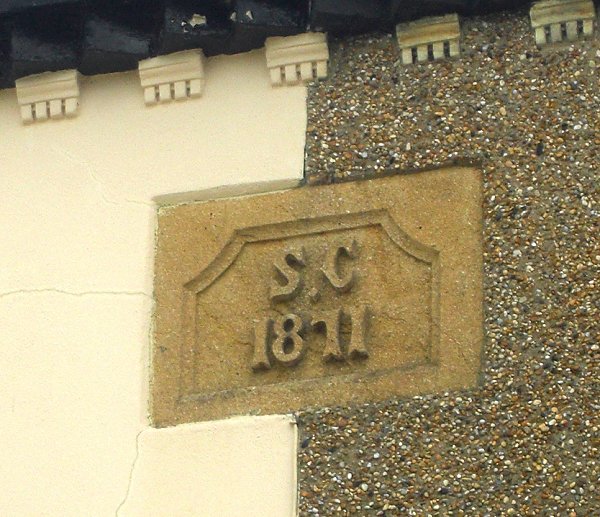
Samuel Cridland's 1871 datestone in North Terrace. Note the attention to architectural detail - at very top, immediately beneath the eaves, are bricks laid at an angle (here unfortunately painted black) with stylised Greek elements (regulae and guttae) below. Photographed in 2014.
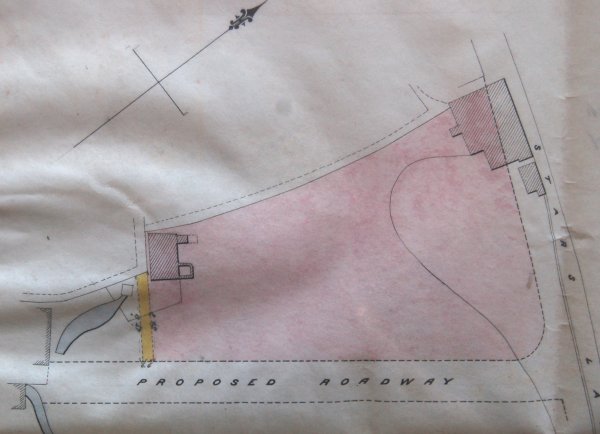
From an
indenture in my
collection
The 1877 map above shows Stars Lane House and its gardens coloured pink. The dotted 'Proposed Roadway' running along the bottom was to become Summerhouse Terrace.
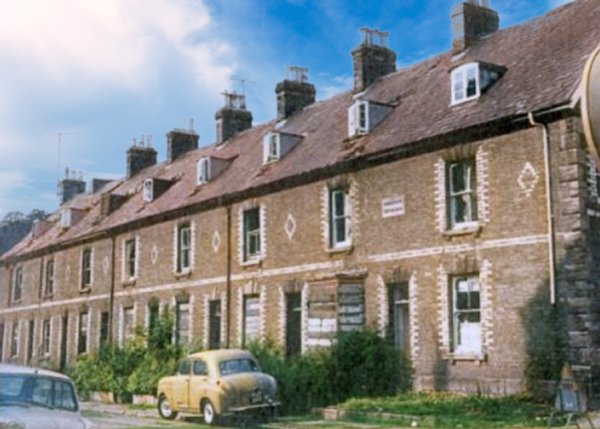
The terrace of houses known as Summerhouse Terrace, almost certainly built by Samuel Cridland in 1875, boarded up and awaiting demolition in the mid-1960s.
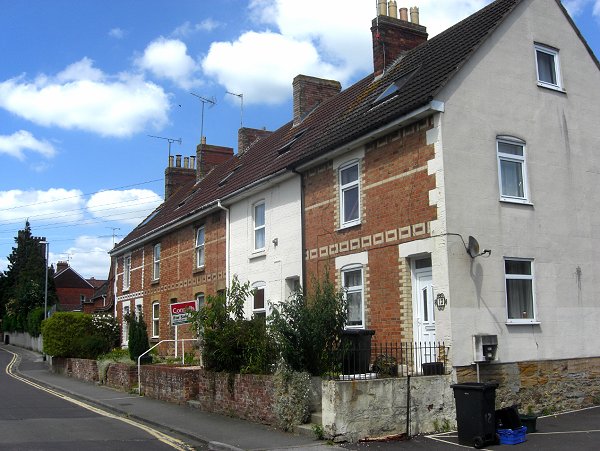
Gladstone Terrace in St Michael's Avenue, built by Samuel Cridland in 1886. Such a shame that people find it necessary to paint over stone and brickwork to ruin an otherwise pleasing street scene elevation. Photographed in 2014.
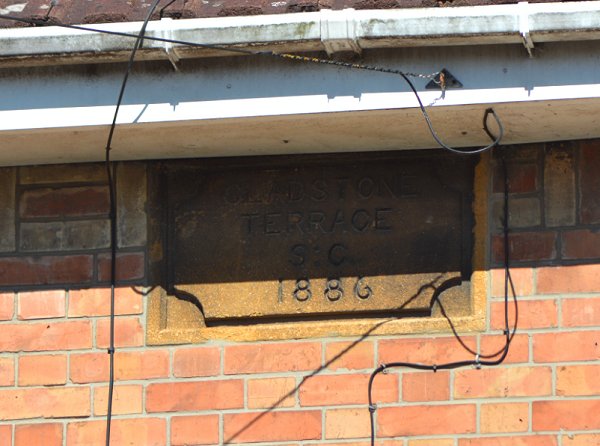
The datestone - Gladstone Terrace over SC 1886. Photographed in 2014.
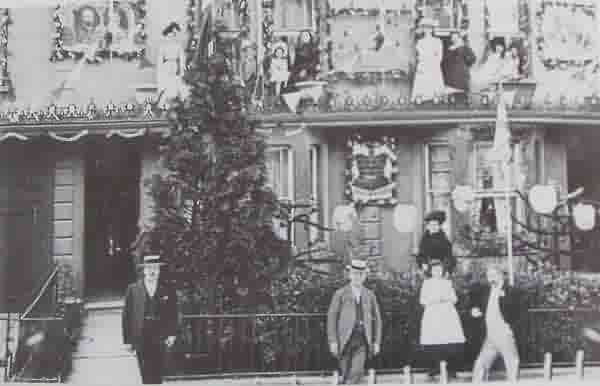
Courtesy of
Roger McElliott
62 South Street (see next photo) decked out with flags and bunting for the Coronation of King Edward VII and Queen Alexandra in 1902
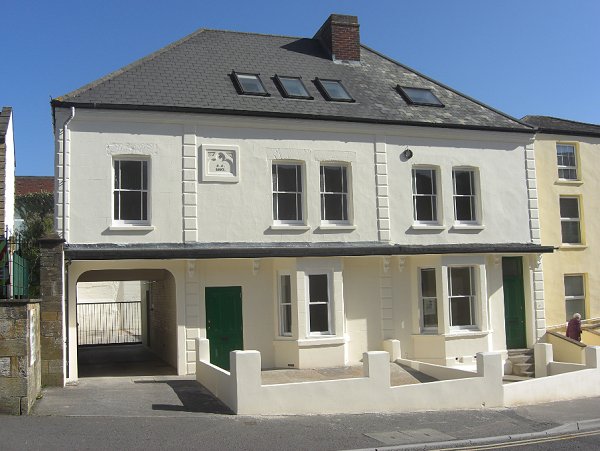
A pair of houses built by Samuel Cridland in South Street in 1887 - his home perhaps? Photographed in 2014.
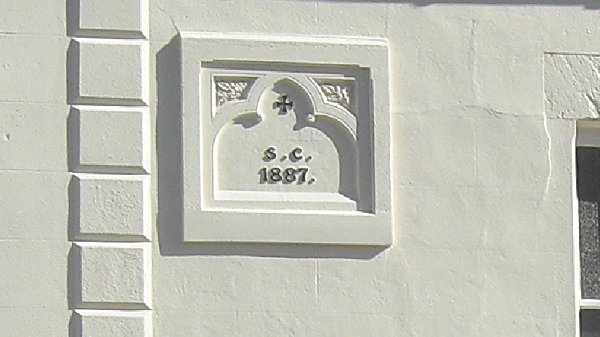
The 1887 datestone with Samuel Cridland's initials on the above South Street property.